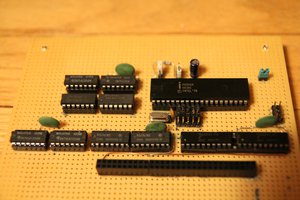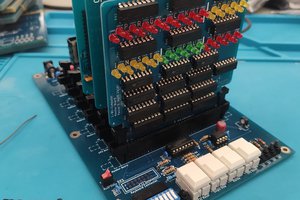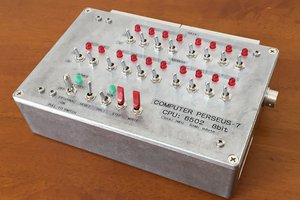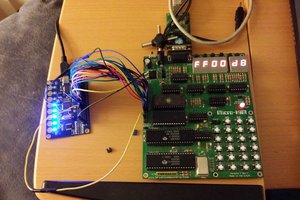This bus monitor has the obligatory binary LEDs for the address, data, and status lines but it also offers a single stepping and automatic slow stepping capabilities. Finally, it has room for three EPROMS onboard, one that can hold the 8008 resident monitor MON8, one that can hold the 8080 resident monitor MON80, and one that can hold a 2732 with user code. Each have their own address decoder with DIP switches to place where desired (obviously the two set for 0000 if used for resident monitors). The eproms also have easy enable/disable toggle switches for the times it is needed to easily swap code in and out.
What originally started as just a simple add-on memory card turned into a full blown bus monitor. For the EPROMS, the card can hold a 2716 which matches the original 2K EPROM board used with the 8008 resident monitor MON8, it can hold a 2716 to replace the two 2K EPROM cards needed for the 8080 resident monitor MON80, and it has an additional 2732 EPROM for user code. Each of the EPROMS have a DIP switch for address selection and an enable/disable switch for easy swap or even hot-swap if needed to swap out memory space.
Since it is always nice to single step, the board has a toggle switch to turn the single step off and on as well as a momentary "step" button to advance. In addition to the single step, there is a 'slow-step' which utilizes a 555 configured as an astable with an onboard potentiometer to adjust the step rate from about 0.5Hz to 60Hz.
As with any bus monitor, it also has LEDs to display all 14 or 16 address bits, 8 data bits, bus status, and if it is on the 8008 there are LEDs to show the processor flags.
finally, I added one port to the board so the software can be used to enable/disable the single step which is useful to allow the program to run full speed until getting to the area of interest and then switch to single or slow-step. This port also controls an onboard speaker so tones can be made via toggling that bit.
With the lessons learned from this bus monitor, I decided to add a few more bells and whistles to the design and recreate a bus monitor for the SBC-85 8085 based computer system. More information on that project is here on hackaday or hereon the SBC-85 website.
The rest of the MIL MOD8 and the storehouse of MIL MOD information can be found on Charles Baetsen's website
 Craig
Craig
 Bentendo64
Bentendo64
 Pascal
Pascal
 Mitsuru Yamada
Mitsuru Yamada
 Jac Goudsmit
Jac Goudsmit